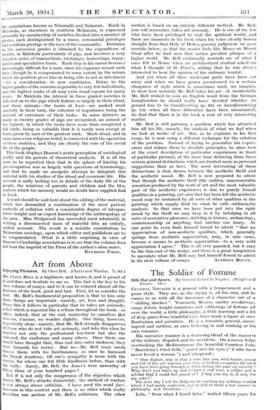Art from Above Enjoying Pictures. By Clive Bell. (Chatto and
Windus. 7s. 6d.) Mn. CLIVE BELL is a highbrow, and knows it, and is proud of it, and does not hesitate to say so. This fact is the key to his new volume of essays, and to it can be reduced almost all the features of the book, good and bad. First, let us consider the bad. Mr. Bell's fundamental proposition is that to him only three things are important—namely, art, love and thought. From this it follows in particular that he takes art seriously, a fact which is repeated like a refrain throughout the book—so often, indeed, that at the end, muttering to ourselves Qui s'excuse, s'accuse, we wonder slightly. One thing, however, is perfectly clear—namely, that Mr. Bell strongly disapproves of those who do not take art seriously, and into this class he bundles not only the professional low-brow but also the Cultured, the craftsman and many others. Once there, one would have thought that, thus cast into outer darkness, they were beneath his notice. But no—Mr. Bell must needs harass them with his facetiousness, as once he harassed the Royal Academy, till one's sympathy is more with the victim, for whom one felt little kindliness before, than with the bully. Surely, Mr. Bell, the Jones's were unworthy of filling three of your hundred pages ?
But it is not only the meagreness of the objective which makes Mr. Bell's attacks distasteful ; the method of warfare is not always above criticism. I have used the word face- tiousness in this context and there is no other which really describes one section of Mr. Bell's criticisms. The other section is based on an entirely different method. Mr. Bell, you will remember, takes art seriously. He is one of the few who have been privileged to visit the spiritual world, and there are moments in his book when his voice clearly booms straight from that Holy of Holies, passing judgment on poor mortals below, so that the reader feels like Moses on Mount Sinai after he had seen that rather peculiar glimpse of a higher world. Mr. Bell continually reminds me of what I once felt in Rome when an architectural student asked me what I thought of St. Peter's, adding that he was always interested to hear the opinion of the ordinary tourist.
And yet when all these irrelevant parts have been cut away and when we have grown accustomed to a certain cheapness of style which is sometimes used, we imagine, to show how seriously Mr. Bell takes his art—if, incidentally Mr. Bell wished to coin an English word from the German kunstforschen he should really have decided whether its gerund was to be kunstforsching (p. 62) or kunstforschering (p. 14)—when all these difficulties have been surmounted, we find that there is in the book a core of very interesting matter.
Mr. Bell is still pursuing a problem which has attracted him all his life, namely, the analysis of what we feel when we look at works of art. But, as lie explains in his first essay, he is now using a different technique for the solution of the problem. Instead of trying to generalize his experi- ences and reduce them to absolute principles, he aims now at the exact description of particular experiences in front of particular pictures, at the same time deducing from them certain general distinctions which are treated more as personal suggestions than as laws. The most interesting of these distinctions is that drawn between the aesthetic thrill and the aesthetic mood. Mr. Bell is now prepared to admit that though the aesthetic thrill (the sudden, tinaccountable sensation produced by the work of art and the most valuable part of the aesthetic experience) is due to purely formal qualities in a painting, yet once that has been felt the aesthetic mood may be sustained by all sorts of other qualities in the painting which supply food for what he calls enthusiastic- analysis. So that once we have been put into the right mood by the thrill we may keep in it by indulging in all sorts of associative pleasures, dabbling in history, archaeology, connoisseurship or anything that catches our fancy. At one point he even finds himself forced to admit " that an appreciation of non-aesthetic qualities, which generally springs from aesthetic appreciation, may, in rare cases, become a means to aesthetic appreciation—to a very mild appreciation I agree." This is all very guarded, but it may be the thin end of the wedge, and there is a great temptation to speculate what Mr. Bell may find himself forced to admit








































 Previous page
Previous page